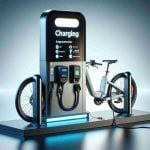The future of energy storage is set for a massive leap as solid-state batteries are projected to escalate from a valuation of $0.5 billion in 2020 to an astounding $3.4 billion by 2030. This represents a remarkable growth trajectory with a compound annual growth rate (CAGR) of 18% during this decade, as detailed in a comprehensive market analysis by Allied Market Research.
Solid-state batteries, distinct from traditional lithium-ion types, leverage a solid electrolyte, enhancing their energy density, safety, and lifespan. These features fuel significant research and development, attracting considerable interest in various sectors.
As of 2020, the Asia-Pacific region dominated, contributing over 38% of the market revenue. It is anticipated that Europe will witness the highest growth rate of 18.5% through 2030, driven by the region’s expanding electric vehicle sector and the evolution of renewable energy systems. Leading players in this burgeoning market include renowned companies such as LG Energy Solution, Samsung SDI, and Bosch’s subsidiary, Seeo Inc.
Applications in consumer electronics are a key driver, with the sector maintaining dominance due to escalating consumer expenditures on gadgets like smartphones and laptops. Safety concerns associated with liquid-based batteries are propelling the shift towards solid-state variations.
Despite promising projections, the high cost and intricate manufacturing processes pose challenges. Yet, with giants like Samsung and Hyundai investing heavily, there are abundant opportunities for innovation and market expansion.
Overall, solid-state batteries are on course to revolutionize the energy storage landscape, offering sustainable and safer power solutions across multiple applications.
Are Solid-State Batteries the Ultimate Solution for a Greener Future?
As the demand for cleaner and more efficient energy solutions intensifies, the spotlight turns to the innovative technology of solid-state batteries. With the potential to reshape various industries, this emergent technology goes beyond the realms of energy storage, influencing everything from electric vehicles to portable electronics. But what does this mean for global communities, and how are nations preparing to adapt to this technological breakthrough?
Impact on Communities and Nations
The adoption of solid-state batteries is expected to drastically change how energy is stored and utilized across different sectors. For local communities, this could mean access to more reliable energy sources, especially in regions prone to power outages. As solid-state batteries are known for their longer lifespan and higher efficiency, countries may see a reduction in reliance on fossil fuels, fostering a significant decrease in carbon emissions.
On a national level, governments may face pressure to overhaul existing infrastructure to accommodate this new technology, potentially leading to significant job creation in sectors like manufacturing and engineering. Countries that are quick to embrace solid-state technologies could position themselves as leaders in the global transition to renewable energy.
Exciting Facts and Controversies
Did you know? Solid-state batteries are being touted for their potential to power an electric airplane. As aviation is one of the largest carbon dioxide-emitting sectors, solid-state technology could signal a monumental shift towards reducing the industry’s carbon footprint.
However, the onset of this technology is not without controversy. A contentious debate continues over the environmental impact of extracting raw materials needed for solid-state batteries, such as lithium and cobalt. While the end product is more sustainable, the means of production raise ethical and environmental questions.
Advantages and Disadvantages
Advantages
– Higher Energy Density: Solid-state batteries can store more energy, making them ideal for electric vehicles and advanced consumer electronics.
– Increased Safety: By eliminating liquid electrolytes, these batteries significantly reduce the risk of leaks and fires.
– Longer Lifespan: These batteries tend to have a much longer lifecycle, reducing the need for frequent replacements and thus minimizing electronic waste.
Disadvantages
– Cost: The steep cost of production remains a significant barrier to widespread adoption.
– Production Complexity: Manufacturing these batteries is technologically challenging and requires significant advancements and investments.
Frequently Asked Questions
Q: How soon can we expect solid-state batteries to become mainstream?
A: While some experts predict solid-state batteries may not be widely available until the end of this decade, ongoing developments and investments could expedite their commercial availability.
Q: Will the adoption of solid-state batteries eliminate the need for traditional lithium-ion batteries?
A: Not entirely. Although solid-state batteries have several advantages, traditional lithium-ion batteries remain more cost-effective for many applications, especially in lower-end consumer electronics.
Future Prospects
The promising future of solid-state batteries suggests an inherent shift towards more sustainable energy alternatives. As major companies invest billions into research and development, consumers globally will likely see a wider range of applications incorporating this technology in the coming years.
To explore more about the potential of solid-state batteries and other energy solutions, check out GreenTech Media for the latest industry insights and analyses.







